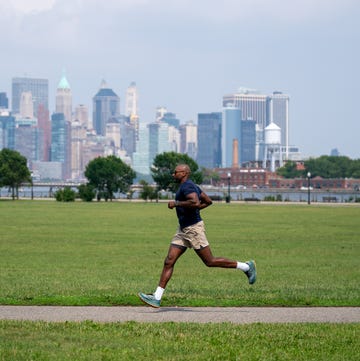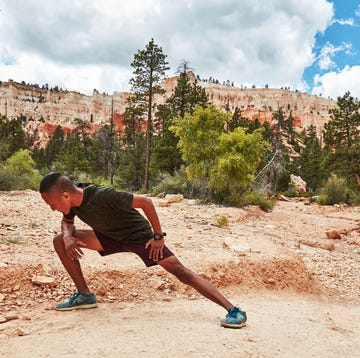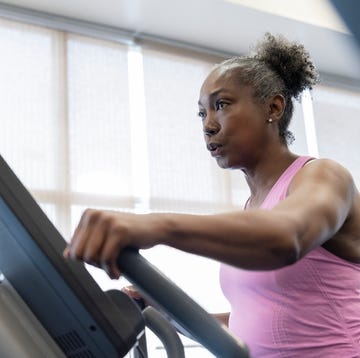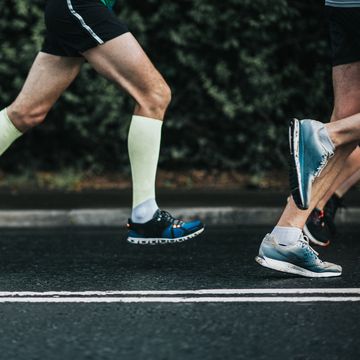British ultrarunner Tom Evans has set course records, like his 5:44:22 finish at the South Downs Way 50 in 2018, and placed first in some of the most challenging running events around the world, including the 2023 Western States Endurance Run. Of course, his prep work includes logging lots (and lots) of miles. But he has a surprising tool that propels him toward success: breathing.
“I use the Wim Hof breathing method to calm down and focus before the race,” he’s previously told sponsor Red Bull. “I find it really helps keep my head straight, and I don’t get too nervous.”
Intentionally harnessing your breath may not immediately come to mind when you think about improving your own running. But as breathwork becomes increasingly popular among athletes of all kinds, it’s only natural to wonder if it could give you an edge.
Here’s what you should know before trying the particular approach of Wim Hof breathing.
The Wim Hof Method of Breathing—Explained
Wim Hof is a Dutch extreme athlete who pushes the limits on outdoor adventure in the cold; he’s known for climbing Mount Kilimanjaro in shorts, for example. His endeavors have (understandably) impressed many less extreme athletes who are inspired to follow some of his training tips.
The Wim Hof Method is three-pronged: It involves breathing exercises, cold immersion, and commitment and mindset, which involves cultivating your focus and determination.
His breathing method, specifically, comes with a few basic guidelines:
- Sit or lie down in a comfortable position.
- Inhale deeply through the nose or mouth and extend your belly. When lungs are full, exhale through the mouth without force.
- Take 30 breaths like this, one right after the other. (You should perform these breaths quickly.)
- After you exhale the final time, hold your breath as long as you can.
- Then take a giant inhale, and hold it for 15 seconds.
- That’s one round. Repeat it for 3-4 rounds.
Hof recommends doing this right after you wake up or right before a meal so your stomach is empty.
What This Breathing Technique Does to the Body
The 30 fast breaths essentially get you into a state of hyperventilation, which means you’re breathing more quickly than you would typically, Milica McDowell, D.P.T., an exercise physiologist, physical therapist, and vice president of operations at Gait Happens, tells Runner’s World.
And hyperventilation brings about some expected physiological changes, McDowell explains. “Our respiratory system is designed to bring oxygen in and take carbon dioxide out. And our body has all sorts of sensors that respond if your oxygen levels get too low or your carbon dioxide levels get too high,” she says. One obvious one is when you’re not getting enough oxygen, you’ll find yourself huffing and puffing, she explains. That increase in your breathing is your body responding to an imbalance in oxygen and carbon dioxide.
When that balance is off, it can actually change the pH of your blood to be more basic, also called acute respiratory alkalosis, explains Kenzie Johnston, M.D., a primary care sports medicine physician and an assistant professor in family medicine and community health at Duke University School of Medicine.
“You’re breathing off a ton of carbon dioxide and creating a state of what we call hypocapnia, which is another term for low carbon dioxide,” Johnston explains. “And then after that, you’re doing these prolonged breath holds, which then creates a state of hypoxia, or low oxygen. And as you’re doing the breath holds, the carbon dioxide content in the blood also starts to come back up.”
The Potential Benefits
So is the oxygen and carbon dioxide imbalance a good thing? Well, there are a number of theoretical benefits of adopting this type of practice, but so far, there isn’t much research to support them, Johnston says.
For starters, all of that deep breathing might prime your lungs for exercise, because it tells your lungs, blood vessels, and muscles involved in breathing to get to work, Johnston says. That may potentially help you breathe a little easier during running or other cardiovascular exercise.
One systematic research review of nine studies, looking at the effects of the Wim Hof method, found mixed results for the breathing technique’s effects on exercise performance. However, researchers called out its potential for reducing inflammation, though those advantages were evident when cold exposure was included. Other studies have found no noticeable differences in breathing during exercise for people who practice the Wim Hof way.
Another theory is the short period you’re low on oxygen could later support your ability to transport oxygen all around your body when you need it during other activity, Johnston says.
A small pilot study on 15 amateur runners didn’t find any benefits during repeated bouts of sprinting, at least when doing one session of the Wim Hof breathing exercise before the anaerobic workout.
A little more convincing to our experts was the potential for a psychological edge in running. “That’s actually a big part of both the breathing exercises and the cold water immersion in the Wim Hof Method,” McDowell says. “You’re getting comfortable being uncomfortable, which is a ‘muscle’ you have to train.”
Regularly trying this breathing practice might make you a grittier, tougher runner, McDowell says. “If you’re used to doing things that make you uncomfortable in controlled environments, and you can really adapt this psychological fortitude to tolerate it, when you’re running up a hill at mile 24 of a marathon, you’re [able to] tap into that experience,” she says.
Plus, “after this breathing practice, there’s an increased recruitment of the parasympathetic system—that’s the restful state, that’s the opposite of the flight-or-fight state,” Johnston says. “That recruitment of the parasympathetic system could then lead to stress regulation, stress reduction, and an increase in mental focus for athletes.” And research consistently shows that various types of breathing exercises result in reduced markers of stress in the body.
Some studies also suggest people who follow this method of breathing have improved focus and pain tolerance, Johnston adds.
Are There Any Risks?
The Wim Hof method of breathing is generally safe to try, as long as you keep in mind a few important considerations.
You may feel a little lightheaded or faint when you breathe this way—you are essentially hyperventilating, after all. You should never do it while driving or if you’re in or near water, according to the Wim Hof Method website.
You might not want to do it while you’re home alone, either—at least until you’re a little more comfortable with the effects, McDowell says. “A lot of times well recommend folks do it seated or lying down, just because if they do start to feel lightheaded, they’re not at a risk of passing out and hitting their head or falling,” she adds.
You might also feel some numbness and tingling in your hands and feet. This isn’t necessarily a risk; it’s actually a pretty normal physiological reaction to your blood pH changing because your oxygen and carbon dioxide are out of their usual balance, McDowell says.
One important note: Anyone with an underlying respiratory condition should get cleared by their doctor before they try any new type of breathing exercise, Johnston cautions.
How to Try the Wim Hof Method of Breathing as a Runner
As long as you keep the risks mentioned above in mind, you can try the Wim Hof breathing method; you can even follow along with a video of a guided breathing session from Wim Hof himself.
Just know you’ll probably need to stick with it for a while if you’re going to notice any results with your running. “If you do this once, nothing chronic is going to change,” McDowell says. To follow the Wim Hof method to a T, you need to practice daily to see benefits, ideally right after you wake up or before a meal.
Johnston recommends not doing it right before a run. “I think there is some danger with hyperventilating right before you [exercise},” she says. “You might be lightheaded or dizzy.”
Otherwise, “it’s a low-risk, no-cost method that may improve your focus and perceived exertion with the following workout, so I think it’s reasonable to try,” she says.














